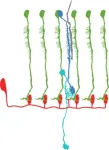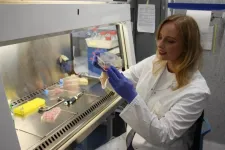(Press-News.org) Rice University together with Baylor College of Medicine and the Houston Methodist Academic Institute has awarded seed grants in support of research on health equity and digital health.
Spearheaded by Rice’s Educational and Research Initiatives for Collaborative Health (ENRICH) office in collaboration with the two partnering institutions in the Texas Medical Center (TMC), the seed grant opportunity followed the Health Equity Workshop hosted earlier this year by Rice’s Digital Health Initiative.
“To achieve equitable health outcomes, a comprehensive approach is essential — one that spans all phases of digital health from technology design and development to implementation, dissemination and long-term sustainability,”said Ashutosh Sabharwal, who leads the Digital Health Initiative and serves as Rice’s Ernest Dell Butcher Professor of Engineering and a professor of electrical and computer engineering.
The workshop chaired by Momona Yamagami, an assistant professor of electrical and computer engineering at Rice, aimed to bring together scientists and clinicians working on health equity research to foster new collaborations and identify a shared research agenda across disciplines.
“This seed grant not only fosters interdisciplinary collaborations between Rice University and the Texas Medical Center but also enables us to leverage our combined knowledge to enhance innovations in health equity and digital health, ultimately creating impactful solutions for improving patient care,” said Sharon Pepper, executive director of ENRICH.
The two projects, which were each awarded a total of $50,000 in matching funds from the partnering institutions, are:
Evaluating Equity and Community-Level Vulnerabilities in the Use of Generative Artificial Intelligence-based Symptom Checkers for Self-diagnosis
Primary investigators:
● David Abraham, lecturer in biosciences, Wiess School of Natural Sciences, Rice University
● Evan Siemann, the Harry C. and Olga K. Professor of BioSciences, Wiess School of Natural Sciences, Rice University
● Dr. LeChauncy Woodard, associate professor, Medicine-Health Services Research, Baylor College of Medicine
This project aims to mitigate vulnerabilities for patients using AI-based symptom checkers, both within the technical built environment and the broader community. It focuses on improving data precision, ensuring policies are appropriate for all patients, addressing social and cultural differences and fostering public trust through education.
Al-Driven ECG Analysis for Equitable Cardiovascular Risk Assessment and Prevention: Leveraging Transformer Models and Big Data to Reduce Health Disparities
Primary investigators:
● Guha Balakrishnan, assistant professor of electrical and computer engineering, George R. Brown School of Engineering and Computing, Rice University
● Dr. Sadeer Al-Kindi, associate professor of cardiology, Katz Investigator, DeBakey Heart & Vascular Center, Houston Methodist
This proposal focuses on advancing the application of AI methodologies to harness the untapped potential of electrocardiogram data for improving cardiovascular risk assessment. The goal is to develop a low-cost, noninvasive tool for optimizing preventive care resource allocation and reducing cardiovascular health disparities.
This is the second round of seed grants awarded through this initiative to research projects advancing digital health and health equity, further strengthening Rice’s commitment to creating equitable health care for the future.
As Rice continues to establish itself as a leading nonmedical institution in health research and innovation, the ENRICH office will play a pivotal role in promoting collaboration with partner institutions at the TMC, Pepper said, ensuring that every partnership is founded on trust, academic excellence and research innovation, leveraging the expertise of the partners.
— by Angie Arranz Abreu, marketing, events and administrative specialist, Rice ENRICH
END
Rice, Texas Medical Center institutions jointly award seed grants
Two teams win funding from Rice ENRICH, Baylor College of Medicine and Houston Methodist Academic Institute
2024-10-31
ELSE PRESS RELEASES FROM THIS DATE:
Sleeping for 2: Insomnia therapy reduces postpartum depression, study shows
2024-10-31
While many people believe that poor sleep during pregnancy is inevitable, new research has determined that cognitive behavioral therapy for insomnia (CBTi) while pregnant can not only improve sleep patterns but also address postpartum depression.
Researchers from UBC’s Okanagan and Vancouver campuses, as well as the University of Calgary, discovered that delivering CBTi during pregnancy significantly reduces postpartum depressive symptoms after a baby arrives.
“Early intervention is crucial for infant and parental mental health,” says Dr. Elizabeth Keys, an Assistant Professor in UBCO’s School of Nursing and a study co-author. “Our research explores how addressing ...
How fruit flies achieve accurate visual behavior despite changing light conditions
2024-10-31
When light conditions rapidly change, our eyes have to respond to this change in fractions of a second to maintain stable visual processing. This is necessary when, for example, we drive through a forest and thus move through alternating stretches of shadows and clear sunlight. "In situations like these, it is not enough for the photoreceptors to adapt, but an additional corrective mechanism is required," said Professor Marion Silies of Johannes Gutenberg University Mainz (JGU). "Earlier work undertaken by her research group had already demonstrated that such a corrective 'gain control' mechanism exists ...
First blueprint of the human spliceosome revealed
2024-10-31
Researchers at the Centre for Genomic Regulation (CRG) in Barcelona have created the first blueprint of the human spliceosome, the most complex and intricate molecular machine inside every cell. The scientific feat, which took more than a decade to complete, is published today in the journal Science.
The spliceosome edits genetic messages transcribed from DNA, allowing cells to create different versions of a protein from a single gene. The vast majority of human genes – more than nine in ten – are edited by the spliceosome. Errors in the process are linked to a wide spectrum of diseases including most types of cancer, neurodegenerative conditions and genetic ...
The harmful frequency and reach of unhealthy foods on social media
2024-10-31
An analysis of social media posts that mention food and beverage products finds that fast food restaurants and sugar sweetened beverages are the most common, with millions of posts reaching billions of users over the course of a year. The study, published in the open access journal PLOS Digital Health, highlights the sheer volume of content normalising unhealthy eating, and argues that policies are needed to protect young people in the digital food environment.
Obesity is a health challenge around the world and food environments, including in the digital space, can influence ...
Autistic traits shape how we explore
2024-10-31
People with stronger autistic trails showed distinct exploration patterns and higher levels of persistence in a computer game, ultimately resulting in better performance than people with lower scores of autistic traits, according to a new study published this week in PLOS Computational Biology by Francesco Poli of Radboud Universiteit, the Netherlands, and colleagues.
Scientists know that individuals display curiosity and explore their environments to learn. How a person selects what they want to explore plays a pivotal role in how they learn and research has shown that exploration levels are highly variable across ...
UCLA chemists just broke a 100-year-old rule and say it’s time to rewrite the textbooks
2024-10-31
Key takeaways
According to Bredt's rule, double bonds cannot exist at certain positions on organic molecules if the molecule's geometry deviates too far from what we learn in textbooks.
This rule has constrained chemists for a century.
A new paper in Science shows how to make molecules that violate Bredt’s rule, allowing chemists to find practical ways to make and use them in reactions.
UCLA chemists have found a big problem with a fundamental rule of organic chemistry that has been around for 100 years — it’s ...
Uncovered: the molecular basis of colorful parrot plumage
2024-10-31
A single enzyme fine-tunes red and yellow pigments in parrots’ polychromatic plumage, according to a new study. The findings reveal new insights into the molecular mechanisms underlying the evolution and display of color variation in one of nature’s most colorful birds. Colors play a central role in ecological adaptation and communication in the natural world. This is particularly true for birds, which are especially notable among animals for their wide range of vibrant plumage colors and patterns. Among birds, ...
Echolocating bats use acoustic mental maps to navigate long distances
2024-10-31
By blindfolding Kuhl's pipistrelle bats and tracking their movements with novel GPS technology, researchers show that the tiny creatures can navigate over several kilometers using only echolocation. The findings highlight the animal’s ability to create and use detailed mental acoustic maps of their surroundings. Echolocating bats are known for their ability to nimbly avoid obstacles and catch tiny prey using only sound. However, echolocation is short-ranged and highly directional, allowing for the detection of large objects within only a few dozen meters, limiting its effectiveness for navigation compared to other senses, like vision. ...
Sugar rationing in early life lowers risk for chronic disease in adulthood, post-World War II data shows
2024-10-31
Early-life sugar restriction – beginning in utero – can protect against diabetes and hypertension later in life, according to a new study leveraging data from post-World War II sugar rationing in the United Kingdom. The findings highlight critical long-term health benefits from reduced sugar intake during the first 1000 days of life. The first 1000 days from conception – from gestation until age 2 – is a critical period for long-term health. Poor diet during this window has been linked to negative health outcomes in adulthood. Despite dietary guidelines recommending zero added sugar in early life, high sugar exposure is ...
Indigenous population expansion and cultural burning reduced shrub cover that fuels megafires in Australia
2024-10-31
Indigenous burning practices in Australia once halved shrub cover, reducing available fuels and limiting wildfire intensity for thousands of years, but the removal of these practices following European colonization has led to an increase in the tinder that has fueled today’s catastrophic megafires, researchers report. The findings suggest that reintroducing cultural burning practices could provide a strategy to curb future fires. “Through detailed histories of Indigenous burning regimes across the world and Indigenous-led collaborations in contemporary wildfire management ...
LAST 30 PRESS RELEASES:
Scientists use ultrasound to soften and treat cancer tumors without damaging healthy tissue
Community swimming program for Black youth boosts skills, sense of belonging, study finds
Specific depressive symptoms in midlife linked to increased dementia risk
An ‘illuminating’ design sheds light on cholesterol
Who is more likely to get long COVID?
Study showcases resilience and rapid growth of “living rocks”
Naval Research Lab diver earns Office of Naval Research 2025 Sailor of the Year
New Mayo-led study establishes practical definition for rapidly progressive dementia
Fossil fuel industry’s “climate false solutions” reinforce its power and aggravate environmental injustice
Researchers reveal bias in a widely used measure of algorithm performance
Alcohol causes cancer. A study from IOCB Prague confirms damage to DNA and shows how cells defend against it
Hidden viruses in wastewater treatment may shape public health risks, study finds
Unlock the power of nature: how biomass can transform climate mitigation
Biochar reshapes hidden soil microbes that capture carbon dioxide in farmland
Reducing saturated fat intake shows mortality benefit, but only in high-risk individuals
Manta rays create mobile ecosystems, study finds
Study: Mixed results in using lipoic acid to treat progressive multiple sclerosis
Norbert Holtkamp appointed director of Fermi National Accelerator Laboratory
New agentic AI platform accelerates advanced optics design
Biologists discover neurons use physical signals — not electricity — to stabilize communication
Researchers discover that a hormone can access the brain by hitchhiking
University of Oklahoma researcher awarded funding to pursue AI-powered material design
Exploring how the visual system recovers following injury
Support for parents with infants at pediatric check-ups leads to better reading and math skills in elementary school
Kids’ behavioral health is a growing share of family health costs
Day & night: Cancer disrupts the brain’s natural rhythm
COVID-19 vaccination significantly reduces risk to pregnant women and baby
The role of vaccination in maternal and perinatal outcomes associated with COVID-19 in pregnancy
Mayo Clinic smartwatch system helps parents shorten and defuse children's severe tantrums early
Behavioral health spending spikes to 40% of all children’s health expenditures, nearly doubling in a decade
[Press-News.org] Rice, Texas Medical Center institutions jointly award seed grantsTwo teams win funding from Rice ENRICH, Baylor College of Medicine and Houston Methodist Academic Institute



